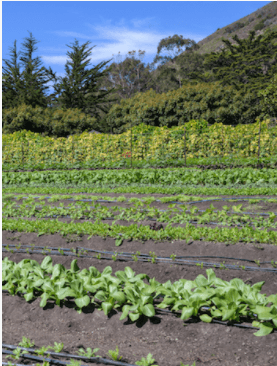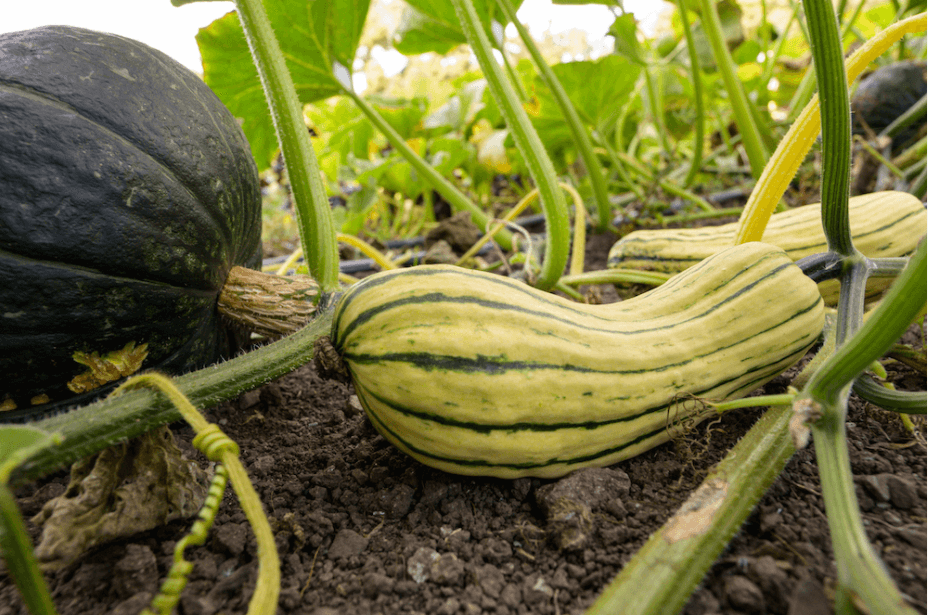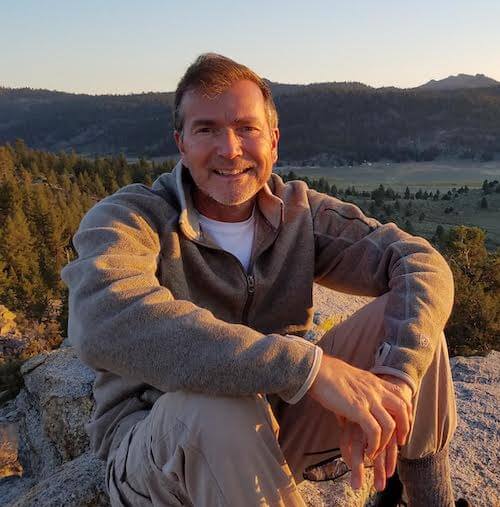
Just as humans benefit from taking time for rest and personal self-care, so do the land and plants at the Esalen Farm & Garden. This is vibrantly visible during the fall months, where cover crops act as a universal metaphor for healthy living.
“Cover crops are integral to our organic farming process at Esalen and you can think of cover cropping as self-care for the field,” says Farm & Garden Manager Chris Omer.
A cover crop is a crop of a specific plant that is grown primarily for the benefit of the soil rather than a crop yield. Cover crops support the overall health and vitality of the fields and their functions are diverse: They slow erosion, improve soil health, enhance water availability, smother weeds, help control pests and diseases, and increase biodiversity. They also increase crop yields, break through compacted layers of soil, add organic matter to the soil, improve crop diversity on farms, and attract pollinators.
“Like self-care, cover crops can ultimately lead to a deeper well of vitality,” Chris says. “They help develop stronger relationships within the soil food web—this includes insects, bacteria, fungi, and more. They also create an environment for the food crops that are planted after it to be more productive.”
On the Esalen farm, the season dictates which cover crop is selected. In the warmer months clover, buckwheat and mustard are planted. During fall and winter, staff generally utilizes a mix of oat grass, bell beans, field peas and vetch, which is a scrambling herbaceous plant of the pea family. With the bulk of what is grown, the farm staff wait until the cover crop develops and eventually flowers. At that point, the fields are mowed down and a tractor-driven spader shovels the crop into the soil to break it down. After three weeks of decomposition, the fields are enriched with nitrogen and other important nutrients, and voila!—they are primed for planting the next round of food crops.
The perks are noticeable. Seminarians may see additional salad bar items in the dining hall during fall, such as tender pea shoots, bell bean tops and mustard leaves. Harvested oats and red clover are used to create nourishing herbal tea blends.
But cover crops are just one of many dynamic elements happening in the fall garden. The harvest beckons, after all, and Chris shares that one of the most exciting fall crops is winter squash, which grow through the summer can easily be stored through winter. Four different types of winter squash are grown at Esalen: delicata, kabocha, butternut and sweet pumpkin. With the exception of delicata, which can be cooked directly after harvest, Esalen’s winter squash needs to be cured.
“In the field, we wait for the plant to fully die back and for the stem of the winter squash to brown up,” Chris explains. “At this point we harvest the squash and store them in a dry location for a few weeks as sugars continue to develop in their flesh, thus sweetening the flavor.”
Afterward, the squash is stored through winter and used by the kitchen upon request.
To that end, the fall garden is self-care at its finest. From cover crops to harvesting squash, we see how mindfulness and allowing time for things to sweeten can produce fruitful yields all around.


“Remembering to be as self compassionate as I can and praying to the divine that we're all a part of.”
–Aaron
“Prayer, reading, meditation, walking.”
–Karen
“Erratically — which is an ongoing stream of practice to find peace.”
–Charles
“Try on a daily basis to be kind to myself and to realize that making mistakes is a part of the human condition. Learning from our mistakes is a journey. But it starts with compassion and caring. First for oneself.”
–Steve
“Physically: aerobic exercise, volleyball, ice hockey, cycling, sailing. Emotionally: unfortunately I have to work to ‘not care’ about people or situations which may end painfully. Along the lines of ‘attachment is the source of suffering’, so best to avoid it or limit its scope. Sad though because it could also be the source of great joy. Is it worth the risk?“
–Rainer


“It's time for my heart to be nurtured on one level yet contained on another. To go easy on me and to allow my feelings to be validated, not judged harshly. On the other hand, to let the heart rule with equanimity and not lead the mind and body around like a master.”
–Suzanne
“I spend time thinking of everything I am grateful for, and I try to develop my ability to express compassion for myself and others without reservation. I take time to do the things I need to do to keep myself healthy and happy. This includes taking experiential workshops, fostering relationships, and participating within groups which have a similar interest to become a more compassionate and fulfilled being.“
–Peter


“Self-forgiveness for my own judgments. And oh yeah, coming to Esalen.”
–David B.
“Hmm, this is a tough one! I guess I take care of my heart through fostering relationships with people I feel connected to. Spending quality time with them (whether we're on the phone, through messages/letters, on Zoom, or in-person). Being there for them, listening to them, sharing what's going on with me, my struggles and my successes... like we do in the Esalen weekly Friends of Esalen Zoom sessions!”
–Lori

“I remind myself in many ways of the fact that " Love is all there is!" LOVE is the prize and this one precious life is the stage we get to learn our lessons. I get out into nature, hike, camp, river kayak, fly fish, garden, I create, I dance (not enough!), and I remain grateful for each day, each breath, each moment. Being in the moment, awake, and remembering the gift of life and my feeling of gratitude for all of creation.”
–Steven
“My physical heart by limiting stress and eating a heart-healthy diet. My emotional heart by staying in love with the world and by knowing that all disappointment and loss will pass.“
–David Z.
Today, September 29, is World Heart Day. Strike up a conversation with your own heart and as you feel comfortable, encourage others to do the same. As part of our own transformations and self-care, we sometimes ask for others to illuminate and enliven our hearts or speak our love language.
What if we could do this for ourselves too, even if just for today… or to start a heart practice, forever?

Just as humans benefit from taking time for rest and personal self-care, so do the land and plants at the Esalen Farm & Garden. This is vibrantly visible during the fall months, where cover crops act as a universal metaphor for healthy living.
“Cover crops are integral to our organic farming process at Esalen and you can think of cover cropping as self-care for the field,” says Farm & Garden Manager Chris Omer.
A cover crop is a crop of a specific plant that is grown primarily for the benefit of the soil rather than a crop yield. Cover crops support the overall health and vitality of the fields and their functions are diverse: They slow erosion, improve soil health, enhance water availability, smother weeds, help control pests and diseases, and increase biodiversity. They also increase crop yields, break through compacted layers of soil, add organic matter to the soil, improve crop diversity on farms, and attract pollinators.
“Like self-care, cover crops can ultimately lead to a deeper well of vitality,” Chris says. “They help develop stronger relationships within the soil food web—this includes insects, bacteria, fungi, and more. They also create an environment for the food crops that are planted after it to be more productive.”
On the Esalen farm, the season dictates which cover crop is selected. In the warmer months clover, buckwheat and mustard are planted. During fall and winter, staff generally utilizes a mix of oat grass, bell beans, field peas and vetch, which is a scrambling herbaceous plant of the pea family. With the bulk of what is grown, the farm staff wait until the cover crop develops and eventually flowers. At that point, the fields are mowed down and a tractor-driven spader shovels the crop into the soil to break it down. After three weeks of decomposition, the fields are enriched with nitrogen and other important nutrients, and voila!—they are primed for planting the next round of food crops.
The perks are noticeable. Seminarians may see additional salad bar items in the dining hall during fall, such as tender pea shoots, bell bean tops and mustard leaves. Harvested oats and red clover are used to create nourishing herbal tea blends.
But cover crops are just one of many dynamic elements happening in the fall garden. The harvest beckons, after all, and Chris shares that one of the most exciting fall crops is winter squash, which grow through the summer can easily be stored through winter. Four different types of winter squash are grown at Esalen: delicata, kabocha, butternut and sweet pumpkin. With the exception of delicata, which can be cooked directly after harvest, Esalen’s winter squash needs to be cured.
“In the field, we wait for the plant to fully die back and for the stem of the winter squash to brown up,” Chris explains. “At this point we harvest the squash and store them in a dry location for a few weeks as sugars continue to develop in their flesh, thus sweetening the flavor.”
Afterward, the squash is stored through winter and used by the kitchen upon request.
To that end, the fall garden is self-care at its finest. From cover crops to harvesting squash, we see how mindfulness and allowing time for things to sweeten can produce fruitful yields all around.


“Remembering to be as self compassionate as I can and praying to the divine that we're all a part of.”
–Aaron
“Prayer, reading, meditation, walking.”
–Karen
“Erratically — which is an ongoing stream of practice to find peace.”
–Charles
“Try on a daily basis to be kind to myself and to realize that making mistakes is a part of the human condition. Learning from our mistakes is a journey. But it starts with compassion and caring. First for oneself.”
–Steve
“Physically: aerobic exercise, volleyball, ice hockey, cycling, sailing. Emotionally: unfortunately I have to work to ‘not care’ about people or situations which may end painfully. Along the lines of ‘attachment is the source of suffering’, so best to avoid it or limit its scope. Sad though because it could also be the source of great joy. Is it worth the risk?“
–Rainer


“It's time for my heart to be nurtured on one level yet contained on another. To go easy on me and to allow my feelings to be validated, not judged harshly. On the other hand, to let the heart rule with equanimity and not lead the mind and body around like a master.”
–Suzanne
“I spend time thinking of everything I am grateful for, and I try to develop my ability to express compassion for myself and others without reservation. I take time to do the things I need to do to keep myself healthy and happy. This includes taking experiential workshops, fostering relationships, and participating within groups which have a similar interest to become a more compassionate and fulfilled being.“
–Peter


“Self-forgiveness for my own judgments. And oh yeah, coming to Esalen.”
–David B.
“Hmm, this is a tough one! I guess I take care of my heart through fostering relationships with people I feel connected to. Spending quality time with them (whether we're on the phone, through messages/letters, on Zoom, or in-person). Being there for them, listening to them, sharing what's going on with me, my struggles and my successes... like we do in the Esalen weekly Friends of Esalen Zoom sessions!”
–Lori

“I remind myself in many ways of the fact that " Love is all there is!" LOVE is the prize and this one precious life is the stage we get to learn our lessons. I get out into nature, hike, camp, river kayak, fly fish, garden, I create, I dance (not enough!), and I remain grateful for each day, each breath, each moment. Being in the moment, awake, and remembering the gift of life and my feeling of gratitude for all of creation.”
–Steven
“My physical heart by limiting stress and eating a heart-healthy diet. My emotional heart by staying in love with the world and by knowing that all disappointment and loss will pass.“
–David Z.
Today, September 29, is World Heart Day. Strike up a conversation with your own heart and as you feel comfortable, encourage others to do the same. As part of our own transformations and self-care, we sometimes ask for others to illuminate and enliven our hearts or speak our love language.
What if we could do this for ourselves too, even if just for today… or to start a heart practice, forever?

Just as humans benefit from taking time for rest and personal self-care, so do the land and plants at the Esalen Farm & Garden. This is vibrantly visible during the fall months, where cover crops act as a universal metaphor for healthy living.
“Cover crops are integral to our organic farming process at Esalen and you can think of cover cropping as self-care for the field,” says Farm & Garden Manager Chris Omer.
A cover crop is a crop of a specific plant that is grown primarily for the benefit of the soil rather than a crop yield. Cover crops support the overall health and vitality of the fields and their functions are diverse: They slow erosion, improve soil health, enhance water availability, smother weeds, help control pests and diseases, and increase biodiversity. They also increase crop yields, break through compacted layers of soil, add organic matter to the soil, improve crop diversity on farms, and attract pollinators.
“Like self-care, cover crops can ultimately lead to a deeper well of vitality,” Chris says. “They help develop stronger relationships within the soil food web—this includes insects, bacteria, fungi, and more. They also create an environment for the food crops that are planted after it to be more productive.”
On the Esalen farm, the season dictates which cover crop is selected. In the warmer months clover, buckwheat and mustard are planted. During fall and winter, staff generally utilizes a mix of oat grass, bell beans, field peas and vetch, which is a scrambling herbaceous plant of the pea family. With the bulk of what is grown, the farm staff wait until the cover crop develops and eventually flowers. At that point, the fields are mowed down and a tractor-driven spader shovels the crop into the soil to break it down. After three weeks of decomposition, the fields are enriched with nitrogen and other important nutrients, and voila!—they are primed for planting the next round of food crops.
The perks are noticeable. Seminarians may see additional salad bar items in the dining hall during fall, such as tender pea shoots, bell bean tops and mustard leaves. Harvested oats and red clover are used to create nourishing herbal tea blends.
But cover crops are just one of many dynamic elements happening in the fall garden. The harvest beckons, after all, and Chris shares that one of the most exciting fall crops is winter squash, which grow through the summer can easily be stored through winter. Four different types of winter squash are grown at Esalen: delicata, kabocha, butternut and sweet pumpkin. With the exception of delicata, which can be cooked directly after harvest, Esalen’s winter squash needs to be cured.
“In the field, we wait for the plant to fully die back and for the stem of the winter squash to brown up,” Chris explains. “At this point we harvest the squash and store them in a dry location for a few weeks as sugars continue to develop in their flesh, thus sweetening the flavor.”
Afterward, the squash is stored through winter and used by the kitchen upon request.
To that end, the fall garden is self-care at its finest. From cover crops to harvesting squash, we see how mindfulness and allowing time for things to sweeten can produce fruitful yields all around.


“Remembering to be as self compassionate as I can and praying to the divine that we're all a part of.”
–Aaron
“Prayer, reading, meditation, walking.”
–Karen
“Erratically — which is an ongoing stream of practice to find peace.”
–Charles
“Try on a daily basis to be kind to myself and to realize that making mistakes is a part of the human condition. Learning from our mistakes is a journey. But it starts with compassion and caring. First for oneself.”
–Steve
“Physically: aerobic exercise, volleyball, ice hockey, cycling, sailing. Emotionally: unfortunately I have to work to ‘not care’ about people or situations which may end painfully. Along the lines of ‘attachment is the source of suffering’, so best to avoid it or limit its scope. Sad though because it could also be the source of great joy. Is it worth the risk?“
–Rainer


“It's time for my heart to be nurtured on one level yet contained on another. To go easy on me and to allow my feelings to be validated, not judged harshly. On the other hand, to let the heart rule with equanimity and not lead the mind and body around like a master.”
–Suzanne
“I spend time thinking of everything I am grateful for, and I try to develop my ability to express compassion for myself and others without reservation. I take time to do the things I need to do to keep myself healthy and happy. This includes taking experiential workshops, fostering relationships, and participating within groups which have a similar interest to become a more compassionate and fulfilled being.“
–Peter


“Self-forgiveness for my own judgments. And oh yeah, coming to Esalen.”
–David B.
“Hmm, this is a tough one! I guess I take care of my heart through fostering relationships with people I feel connected to. Spending quality time with them (whether we're on the phone, through messages/letters, on Zoom, or in-person). Being there for them, listening to them, sharing what's going on with me, my struggles and my successes... like we do in the Esalen weekly Friends of Esalen Zoom sessions!”
–Lori

“I remind myself in many ways of the fact that " Love is all there is!" LOVE is the prize and this one precious life is the stage we get to learn our lessons. I get out into nature, hike, camp, river kayak, fly fish, garden, I create, I dance (not enough!), and I remain grateful for each day, each breath, each moment. Being in the moment, awake, and remembering the gift of life and my feeling of gratitude for all of creation.”
–Steven
“My physical heart by limiting stress and eating a heart-healthy diet. My emotional heart by staying in love with the world and by knowing that all disappointment and loss will pass.“
–David Z.
Today, September 29, is World Heart Day. Strike up a conversation with your own heart and as you feel comfortable, encourage others to do the same. As part of our own transformations and self-care, we sometimes ask for others to illuminate and enliven our hearts or speak our love language.
What if we could do this for ourselves too, even if just for today… or to start a heart practice, forever?